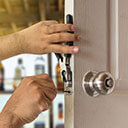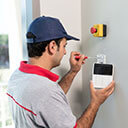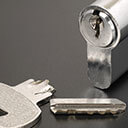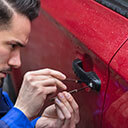What to do if your safe is jammed
What if you suddenly find that you cannot get your safe open? First, don’t go into a panic. It’s certainly inconvenient and annoying when you’re safe won’t function, but you don’t have to let it get to you.
In general, when a safe stops working, it usually happens while it’s locked. Here are some common reasons why your safe won’t open. And, there are things you can try before calling a safe technician.
Dead batteries. It may be this simple. Even if your keypad lights up and beeps as usual, the problem might be as basic as replacing your batteries. Use only reputable brand-name batteries, because off-brands lose power quickly. The truth is, there could be enough power to operate the keypad, yet not quite enough for the bolt work to function.
Lockout mode. Commonly, if you put in too many wrong codes, a safe can go into the penalty lockout mode. Depending on what type of keypad you have, it likely will emit a series of rapid beeps. If this happens, wait 10 to 20 minutes, and try again to open the safe.
Time delay. If your safe has a time delay feature, then you’ll need to wait for the amount of time specified (usually 10 or 20 minutes), and then try re-entering your code.
Deactivated code. Your safe may not open because your code has been deactivated. The safe will have to be reset.
The wiring is disconnected and/or damaged. Your safe’s wiring may have gotten disconnected, or it could also be damaged. Inspect the wiring behind the keypad to see if they’ve come loose, or are kinked or cut.
- If it’s all fine, then temporarily disconnect the wire from the keypad, and remove the batteries. Now, wait 20 seconds or so. Then, reinstall the batteries and reconnect the wiring.
- If the wiring is indeed damaged, then it’s time to call an expert technician.
Jammed bolt work. Can you hear the safe’s motor attempting to retract the bolt work, yet the safe still won’t open? If so, try kicking the door or banging it with a mallet a few times. Yes, you can do this ~ as long as you don’t pound the handle or the keypad. This should loosen the bolt work. After that, try pulling the handle in the opposite direction from what you typically do, and enter your code. This ought to release some of the extra pressure on the bolt, and the handle should move more freely. Do not drill your safe, or you’ll damage it!
If your safe still won’t open, there’s no way around it: You need to hire a professional safe technician.
What if, even though you are using the right combination, it still won’t open? If your safe has a three-wheel combination lock (three digits) then you can try this:
- Turn the dial to the left 4 times, until the first number of your combination is aligned with the opening index. On the fourth time, be sure to stop exactly on your number.
- Next, turn the dial to the right 3 times, until the second number of your combination is aligned with the opening index. On the third time, be sure you stop exactly on your number.
- Now, turn the dial left 2 times, until the third number of your combination is aligned with the opening index. On the second time, be sure to stop exactly on your number.
- Finally, turn the dial right until it stops (at approximately 95). If the dial fails to stop, then try repeating your usual opening procedure, dialing each number of the combination exactly. Keep in mind that the safe is made to stay locked if you dial even a tiny amount past any number you meant to stop on.
- To re-lock the combination lock, turn the dial four complete revolutions to any non-combination number.
If you’ve tried everything, and your safe still won’t open, then you need to get a professional safe technician to take a look.
What if you’re safe stays open, and won’t lock?
- Replace the batteries. Use only name-brand batteries.
- Make sure the edges of the cover are in alignment, and that there’s no debris stuck in the edges.
- Make sure none of the bolts are bent or in any way damaged. Make sure the holes that they go into aren’t blocked by any debris.
- Make sure the door is closed all the way, with the bolts completely engaged correctly.
- Now try “locking” it even though the door stays open. If the locking mechanism still works, then you’ll know that the problem lies elsewhere.
- Lastly, try putting lubricant in the locking mechanism. This may work if a spring is stuck. (Be sure to use the right lubricant. Lubricant for a combination lock differs a bit from lubrication for a keyed lock, which is normally graphite-based.)
If you’ve forgotten or misplaced the combination, or your safe is jammed for any other reason, then you need to find a legitimate safe technician, who will have the experience and expertise to determine exactly what’s causing the problem, and get your safe open without doing any damage to it. A dependable safe technician will make your safe more secure than it was before.
You should never try to “crack” your safe! Opening safes, and working with combination locks (mechanical or digital), are specialized tasks that call for dedicated precision and skill. You need to hire a trusty professional who possesses the wherewithal and thorough understanding of all the maintenance requirements and various locking methods and parameters of today’s safes.
One common mistaken belief about getting your safe opened by an expert is that the safe will be destroyed in the process. Some people claiming to be professionals don’t carry the correct tools and don’t have the right training and credentials, so they cannot be trusted to open your safe. Instead, hire an accomplished safe technician you can absolutely count on, someone who is licensed, certified, background-checked, insured and bonded, who carries the proper tools, and the required sensitivity and skill with sound and touch.
Locksmith Articles
- Have you lost your transponder key
- What to do when dealing with ignition cylinder problems
- Why to call a locksmith during a lockout
- Access control
- Secure your home and garage
- Symptoms of car ignition problems
- Why you should keep a safe in your home
- What to do if your safe is jammed
- When to replace locks
- Having a key replaced better than having it rekeyed
- Additional security
- How to prevent them
- When you face problems with locks and keys
- Get help from a certified locksmith
- Various kinds of locks
- Protecting Your Home When Out Of Town
- VWhen You Should Call for Emergency Locksmith Help







